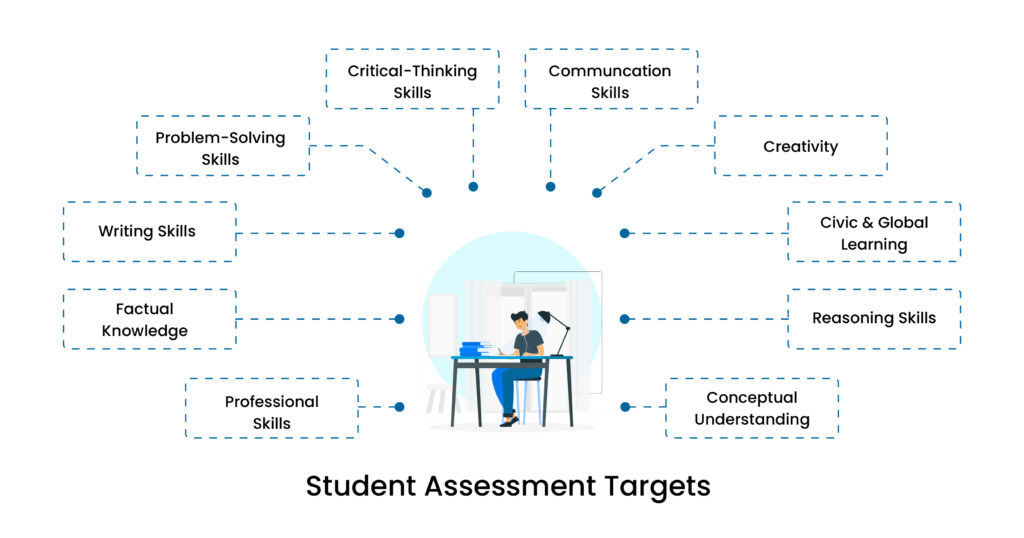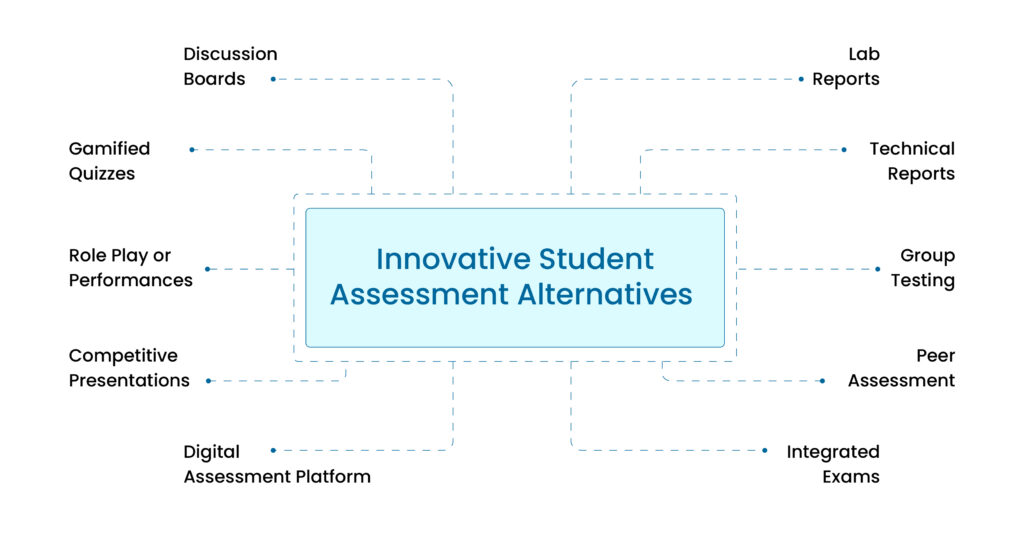Decoding Student Assessment: Redefining Evaluation in the Learning Journey
When we refer to “student assessment,” we’re essentially talking about how we evaluate what students have learned. At the course level, it’s not just about giving grades; it’s about understanding the full picture of how well students are grasping the material. Assessment goes beyond marking papers – it’s a way of figuring out and tracking student progress throughout their learning journey.
Hence, student assessment can be defined as:
“The process of gathering data to better understand the strengths and weaknesses of student learning” – Harris and Hodges, 1995
This is the second installment of our “Smart Assessment” series, delving into the role of student assessment and innovative alternatives. Stay tuned!
The Crucial Role of Student Assessment in the Learning Journey
Evaluation plays a crucial role in the learning and motivation process. The nature of student learning is greatly influenced by their perception of how they will be assessed.
Consider this scenario: A curriculum relying solely on summative assessments places students under pressure during final exams, prioritizing memorization. In contrast, a curriculum with frequent formative assessments may leave learners feeling stressed, as they can be evaluated unexpectedly at any given time.
Given the pivotal role of student assessment, it becomes imperative to contemplate the most effective means of measuring the desired learning outcomes for your students. Efficient student assessment should adeptly fulfill the following roles:
- Diagnose strengths and weaknesses through feedback
- Set clear standards for learning objectives
- Evaluate and track ongoing student progress
- Directly correlate with individual achievements
- Motivate improved performance consistently
Proficient smart assessments enable educators to address the fundamental question: What did my students gain from my course? Consequently, student assessment serves as a lens through which we comprehend student learning, identify concealed obstacles, and refine exiting pedagogies.
Navigating Student Assessment: Prioritizing Precision and Purpose

The foundation of effective student assessment practices lies in your role as an instructor, where you articulate the envisioned learning outcomes for your course. To delineate what learning encompasses in your course and how to assess it, the following questions serve as valuable starting points:
- What specific content knowledge do I anticipate from my students, and at what proficiency level?
- Which cognitive skills do I aim to cultivate in my students throughout the course, and how can I evaluate them?
- Are there transferrable skills or attitudes I anticipate students developing as part of the course?
It is essential to bear in mind that a test or assignment serves as a valid measure only if it effectively draws out the desired type of learning from your students. The essence lies in aligning assessments with the intended learning outcomes.
In the realm of student assessment, exploring innovative alternatives like digital assessment can further bridge the gap between evaluation strategies and the envisioned learning objectives.
Innovative Student Assessment: Crafting Alternate Pathways
While acknowledging the pivotal role of student assessment in shaping learning and motivation, numerous university courses persist in relying on a limited array of assessment techniques predominantly characterized by summative evaluations. These exams tend to prioritize memorization over comprehensive understanding and application of knowledge.
Current conversations on student assessment underscore the necessity for a more dynamic approach, advocating for the integration of diverse digital assessment methods and tools at the course level.
An effective assessment framework should feature clearly defined criteria and actively involve students in the evaluation process, encouraging participation through mechanisms like self- and peer-assessment.
This innovative approach ensures a more comprehensive and nuanced evaluation of various aspects of student learning beyond rote memorization, fostering a richer educational experience.

Breaking the summative assessment cycle is a tough nut to crack. While innovative assessment methods exist, many misconceptions revolve around them.
Debunking Innovative Assessment Myths: Unveiling the Reality
- Myth 1: Alternative Assessments Limit Full Academic Display
Contrary to popular belief, innovative assessments, including digital and smart assessment methods, provide extensive opportunities for students to not only develop but also showcase academic knowledge highly valued by employers and professional bodies. By challenging students to apply theoretical knowledge across diverse mediums and contexts, educators observed a notable enhancement in their overall understanding. - Myth 2: Time-Consuming Instruction and Evaluation
The notion that innovative assessments demand more time for instruction and grading is dispelled through research findings. The form of assessment and student enrollment influenced the duration. Contrary to assumptions, marking criteria creation was the primary time-consuming factor, and once established, subsequent implementations proved more efficient. - Myth 3: Exclusive Domain of Novice Academics
While new academics express eagerness for innovative assessments, long-serving colleagues with over two decades of experience are more likely to have experimented with alternative methods. The perceived difficulty lies not in preference but in the constraints of assignment descriptions, which can limit creativity. The delivery of assessment and its requirement influences the outcomes, not the educator. - Myth 4: Student Disapproval of Alternative Methods
Initial student apprehension towards alternative methods stems from a fear of the unknown rather than a resistance to diverse mediums. Educators note that with clear support and guidance, students embrace innovative assessments positively. The use of technology not only enhances motivation but also positions students as advocates, willingly sharing insights on effective assignment creation. - Myth 5: Resistance from Accrediting Bodies and Examiners
Contrary to misconceptions, professional accrediting bodies actively support and, in some cases, encourage the incorporation of digital assessment methods. External examiners view these innovative approaches as examples of best practice within academic programs, challenging the notion that traditional assessments are universally preferred.
We have highlighted the importance of diverse student assessment methods, now let’s shift our attention to a modern evaluation strategy aimed at strengthening students’ conceptual knowledge.
Möbius Student Assessments: In-Line Questions
Introducing Möbius, a cutting-edge digital learning platform by DigitalEd India, featuring a dynamic component known as “In-Line Questions” designed to dispel the illusion of understanding:
- Seamlessly embed questions within lessons, strategically placed to assess and measure students’ progress as they navigate through the educational material.
- Utilization of diverse question types, including math expressions, HTML, and maple-graded questions, and more, offering a comprehensive approach to evaluating student progress.
- Leverage in-depth insights into students’ understanding and proficiency, enabling valuable and real-time feedback for precise guidance.
In essence, Möbius transforms the learning journey by fostering active engagement and continuous evaluation, making education more personalized, interactive, and conducive to genuine comprehension.
Want to dive deeper? Schedule a personalized demo today!